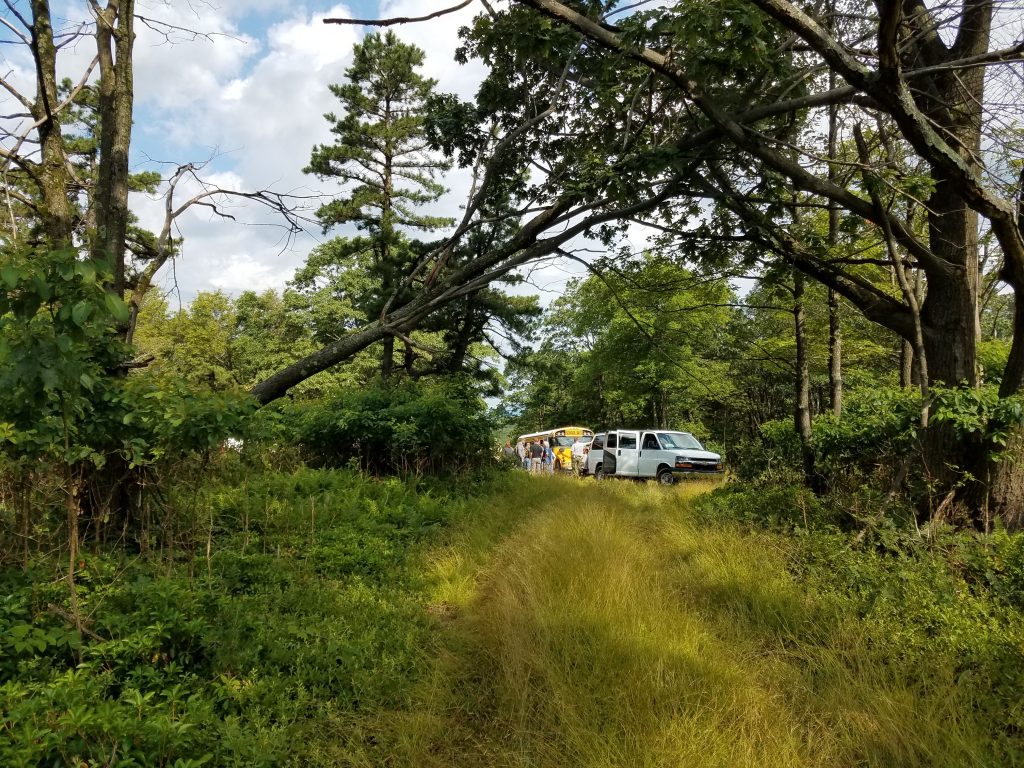Fire in oak forests – field trip – day 2
The ecology of any place is contingent on its history and the oak pitch-pine barrens near State College, PA has an interesting ecological history. And every ecological history includes its human history.
The history of the land matters
We are not sure what the place was like before humans were here, since humans were here since the end of the last ice age. Native Americans used the land and fire was their main tool to change the landscape. Unfortunately, we can only speculate about the various regimes over the past 10,000 years. In the time just before European settlement, Native Americans did not occupy most of this area, although they clearly hunted and burned here. Scientists believe that it was mostly open, widely spaced pitch-pine and oaks, with an understory of scrub oak.
European settlers cleared and farmed most of the land in the valleys. On the hills and the ridges, they cut timber and grazed animals. Most of the woods was cut off by the end of the 19th Century. Some was used for timber, but most was used for fuel, charcoal for steel smelting. We would be appalled if we saw the landscape at that time. The land was denuded and full of ditches used in iron mining.
Bad human behavior past produces good ecological results now
“Bad” human behavior is not always bad for the environment. The barrens is full of amphibians, some rare or threatened, because there are lots of vernal ponds where they can breed. The presence of these vernal ponds does not make sense, since the soil is sandy and drains rapidly – hence the barrens. The reason the ponds do not drain is because people exploiting iron deposits used the pits, which became lined with clays and sediment that hold the water. Ironically, had the environment been better protected in 1900, it would be less productive to the biotic communities today. 1900 was a transition period. It was when people stopped cutting on the barrens and the land began to recover. This ecological history still has great effect on the landscape. Most of the forests are even-aged. They all started to grow up about the same time and the trees are 80-100 years old. There are not many younger trees and no older ones. This produced a beautiful oak forest, but one that was very vulnerable to change.
Being adaptive is more important to being adapted
We visited a site of a beautiful oak forest with trees around 100 years old. The SITE of the forest, since the forest is gone. Gypsy moths in 2008-9 and a drought year killed nearly 100% of the oaks. Because of the even-aged nature of the forest and the deep shade the trees had produced, there was no successor generation. With the big trees dead and the no little trees ready to go, oak trees were almost extirpated from this site. The successors are red maples. Oaks could come back, but not for a long time, since there are no seed sources nearby and acorns do not travel far. Even if they were present, the oaks would have trouble competing with the red maples. This is where fire plays a role. Oaks are relatively better adapted to fire regimes. Of course, if no oaks are present, none can come up, no matter if they are adapted or not to fire.
My own particular plans
One of the very good things about this field trip was that I had the opportunity to talk with Daniel Dey, who literally wrote the book on oak regeneration. I told him about my white oak regen plans. I am happy to say that he thinks it will work. He suggested that I protect my nascent oaks from the coming fire at first, maybe burn in anticipation so that they are not hit by hotter fire. He explained that oaks can sprout from roots for many years, even decades. The existing roots allow the stems to grow very rapidly if the stems are cut of top killed. On the Brodnax place, we can harvest the loblolly in maybe five years, burn and then allow the oaks to regeneration. They are there already. I will need to cut back the gum and poplar to allow the oaks to get to a “competitive stage”. That is a term I learned today. These are oaks that have passed the seedling stage and are above much of the soft competition. My current plan is to allow this regen on the Brodnax place on the first 1/3 of the thinned pines.
My pictures. First is our group at the barrens. Next shows sprouting oak after the burn. Daniel Dey said this is what I should strive for with my oak regen. Picture #3 is s fern thicket. Ferns look nice and they seem pliable, but they can effectively smother and prevent growth of trees. I asked one of the researchers how long this could persist. She told me that absent disturbance, ferns could hold the ground for a very long time. Ecology is contingent. Next picture shows what in Wisconsin we would call oak openings. I love this landscape. Last is a pitch-pine savanna. I would not have recognized the pitch-pine. I just don’t know what they look like. In Virginia, they might be replaced by shortleaf. They looked like shortleaf to me.


